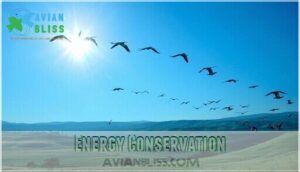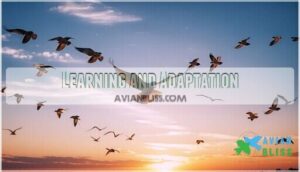This site is supported by our readers. We may earn a commission, at no cost to you, if you purchase through links.

When you watch geese soaring overhead, each bird strategically positions itself to catch the upwash—rising air currents—created by the wingtips of the bird in front.
This invisible aerial highway reduces their energy expenditure by up to 25%, making those exhausting migrations much more manageable.
It’s like drafting behind a cyclist, but in three dimensions.
The lead bird works hardest, which is why they rotate positions regularly.
This coordinated flight pattern represents millions of years of evolutionary fine-tuning, where timing, positioning, and teamwork create an almost perfect energy-saving system that puts our most advanced aircraft designs to shame.
Table Of Contents
- Key Takeaways
- Why Do Birds Fly in V Formation?
- Energy Conservation
- Aerodynamic Advantages
- Upwash and Downwash
- Flapping Coordination
- Learning and Adaptation
- Frequently Asked Questions (FAQs)
- Why do birds fly in a V formation?
- Why do geese fly in a V formation?
- Why do birds have a V shaped wing?
- How do birds decide who leads the V formation?
- Why do birds fly in weird formations?
- Why do birds fly in a bee formation?
- Why do birds fly in a vee formation?
- How do birds decide who leads the V?
- What does it mean when birds fly together in V shape?
- What is birds flying in V formation called?
- Conclusion
Key Takeaways
- You’ll save up to 25% energy when birds fly in V formation by catching upwash from the wingtips of birds ahead, making those long migrations much easier on their bodies.
- You’re watching nature’s version of drafting – each bird strategically positions itself to ride invisible air currents created by their neighbor’s wings, just like cyclists following each other to reduce wind resistance.
- You’ll notice birds rotate leadership positions because the front bird works hardest without benefiting from upwash, so they share the burden to keep everyone fresh during flight.
- You’re seeing millions of years of evolution at work – this coordinated system requires precise timing, positioning, and teamwork that’s more efficient than our most advanced aircraft designs.
Why Do Birds Fly in V Formation?
When you watch birds soar in that distinctive V formation, you’re witnessing nature’s masterclass in flight efficiency.
Through V formation flight, birds harness bird aerodynamics to achieve remarkable energy saving flight by positioning themselves to catch uplifting air currents from their neighbors.
This drafting in flight technique delivers substantial V formation benefits, reducing individual energy expenditure while maintaining formation stability across different species.
This allows them to achieve increased flight range, maximizing their travel distance.
Energy Conservation
When you see birds flying in a V formation, you’re witnessing a real-life energy hack. Each bird positions itself to catch the upwash from the wingtips of the bird ahead, lowering wind resistance and boosting Flight Efficiency.
This teamwork leads to impressive Metabolic Reduction, letting birds stretch their Migration Range and save energy for the long haul. Protecting these vital stopover sites is essential for their continued survival.
Researchers have tracked birds and found that V formation flight brings real energy conservation:
- Lower Heart Rate in trailing birds
- Noticeable bird flight energy savings
- Powerful Drafting Benefits through bird aerodynamics and wingtip vortices
Aerodynamic Advantages
When birds harness V formation, they’re basically riding invisible highways in the sky.
Nature’s ultimate flight hack turns air turbulence into free energy for the whole flock.
The aerodynamic advantages go beyond simple energy savings—each bird strategically positions itself to exploit wingtip vortices from the bird ahead, creating upwash that provides free lift while dramatically reducing resistance.
Here’s how Formation Mechanics work their magic:
- Wingtip Vortices become lift generators: Trailing birds catch the upward air currents spinning off their neighbor’s wings
- Resistance Reduction reaches up to 65%: The slipstream effect means less wind to fight against
- Flight Efficiency improves through shared effort: Each bird contributes to the group’s aerodynamic performance
This isn’t just about following the leader—it’s sophisticated Upwash Exploitation that turns turbulence into an advantage, making the whole flock more efficient than any solo flier.
Birds achieve this flight efficiency partly due to hollow bone structure, which reduces their overall weight.
Upwash and Downwash
In the V formation, you’re witnessing nature’s take on Vortex Interaction and Wake Steering.
Each bird carefully positions its wingtips to ride the upwash—an upward airflow created by the bird ahead.
This clever Wingtip Spacing avoids downwash, or the turbulent air pushing downward, which causes Induced Drag and saps energy.
By mastering these aerodynamics, birds boost Flight Stability and energy efficiency, gliding farther together with less effort than flying solo.
Understanding how birds utilize upwash helps to explain aircraft lift generation.
Flapping Coordination
When birds fly in V formation, they achieve wingbeat synchronization through precise timing and positioning adjustments.
Birds turn flapping wings into a perfectly timed aerial ballet, catching lift from their neighbors’ wingtips.
This coordination enables turbulence avoidance while maintaining formation stability under leader influence.
Here’s how flapping coordination works:
- Real-time positioning – Birds continuously adjust their lateral distance and timing to catch ideal upwash from neighbors’ wingtips
- Visual feedback systems – Quick reaction times under 0.4 seconds help maintain synchronized flapping wings through constant visual cues
- Rhythmic alignment – Up to 70% wingbeat synchronization occurs in tight flocks, with birds timing beats to coincide with beneficial vortex phases
- Individual adjustments – Each bird modifies its bird flight formation position based on airflow changes, optimizing bird wing synchronization for maximum energy savings
This sophisticated V formation coordination reduces energy expenditure by up to 20% compared to solo flight.
This coordination is also a form of avian communication, sharing messages about direction and efficiency.
Learning and Adaptation
Young birds master V formation through social learning, watching experienced adults navigate complex Migration Knowledge.
Juvenile Learning occurs as they observe Leader Navigation techniques, copying wingbeat timing and positioning.
This bird learning process refines flocking behavior over generations.
You’ll notice Formation Evolution happens gradually – inexperienced birds initially struggle with coordination but quickly adapt through practice.
Each migration strengthens their bird flight formation skills, ensuring survival knowledge passes seamlessly between generations.
This conserves energy through significant drag reduction.
Frequently Asked Questions (FAQs)
Why do birds fly in a V formation?
Like cyclists drafting behind teammates, you’ll find migrating birds position themselves to catch upwash from wingtip vortices, reducing energy expenditure by up to 30% during long flights.
Why do geese fly in a V formation?
Geese fly in a V formation because it’s incredibly energy-efficient.
You’ll see each bird positioning itself to catch the uplifting air currents from the wingtips of the bird ahead, reducing their energy expenditure.
Why do birds have a V shaped wing?
When you spread your arms wide like an eagle’s wings, you’ll notice they form a V-shape that’s perfectly designed for flight efficiency.
Bird wings have this V configuration because it maximizes lift while minimizing drag, creating ideal airflow patterns that keep them airborne with less energy expenditure, which is crucial for airborne stability.
How do birds decide who leads the V formation?
Leadership in bird flocks isn’t predetermined—you’ll find experienced adults naturally taking charge through navigational knowledge and confidence.
Only one or two birds actually navigate, while others simply follow their flight path and visual cues.
Why do birds fly in weird formations?
You’ll notice birds flying in odd shapes because they’re smart about saving energy and staying together.
By arranging themselves just right, they reduce wind resistance, communicate easily, and make those epic journeys safer and more efficient, which is a key aspect of their ability to stay together and save energy by being smart.
Why do birds fly in a bee formation?
You’re likely thinking of V formation, not bee formation.
Birds don’t actually fly in bee formations.
The V shape helps you spot how birds save energy by catching uplifting air currents from wingmates ahead.
Why do birds fly in a vee formation?
Though you might think it’s just for show, birds actually fly in V formation to save serious energy.
You’ll find they position themselves to catch uplifting air currents from wingtips ahead, reducing their effort by up to 30 percent during those marathon migrations.
How do birds decide who leads the V?
Birds don’t formally elect leaders – it’s more about experienced adults stepping up when needed.
You’ll find older, seasoned birds naturally taking point while others follow their navigation cues and flight patterns, with experienced adults guiding the way.
What does it mean when birds fly together in V shape?
Ever wonder what’s happening when you spot that perfect aerial arrow cutting through the sky?
You’re witnessing nature’s masterclass in teamwork and efficiency, where each bird strategically positions itself to catch energy-saving updrafts from the wingtips ahead, demonstrating efficiency in flight.
What is birds flying in V formation called?
When you see birds flying in that distinctive V shape, it’s technically called an "echelon formation".
Scientists also refer to it as V-formation flying, which helps these clever birds save precious energy during long migrations.
Conclusion
Nature’s aerial choreography reveals itself when you watch birds soar overhead in perfect formation.
Understanding why do birds fly in v formation shows us how evolution crafted an ingenious energy-saving system through millions of years of refinement.
You’ve witnessed firsthand how upwash from wingtip vortices creates invisible highways that reduce flight effort by up to 25%.
This remarkable coordination combines precise timing, strategic positioning, and seamless teamwork that surpasses our most advanced aviation technology, proving that sometimes nature’s solutions remain unmatched, demonstrating perfect formation.
- https://morassociates.com/insight/wordpressmorassociates-com/five-lessons-from-the-flying-v/
- https://www.smithsonianmag.com/articles/scientists-solve-mystery-birds-flying-v-180949352/
- https://www.loc.gov/everyday-mysteries/zoology/item/why-do-geese-fly-in-a-v/
- https://www.pnas.org/doi/10.1073/pnas.2319971121
- https://suzannewoodsfisher.com/simple-living/give-me-the-simple-life-flying-in-v-formation/






